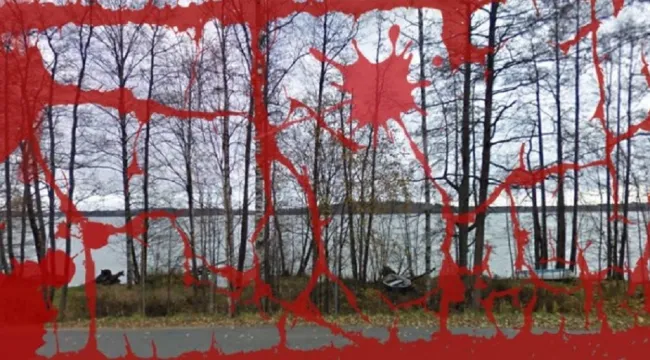Finland lake bodom murders sketch hans assmann funeral picture documentary
Lake Bodom and other Scandinavian crimes
Finland is a stunning country with vast pine and birch forests, peppered with crystal-clear ice-cold waters. These lakes focus on many holiday cottages and camping grounds, as outdoor life is a popular and common pastime with Finns of all ages. But as with all high-latitude countries, endless summer evenings offer a strange quality to an otherwise enchanting scene. The sun doesn't set at night, but the birds still sleep; the forest's stillness sounds eerie, as if a predator is nearby.
Before the 1950s, young explorers and families in the wilderness had only the quietness to fear. But mid-century will carry the nation numerous violent murders and give campers something to think about. None more influenced mainstream culture than the 1960 Lake Bodom murders. Three teens, one survivor. Many offenders, no prosecution.
In this post, I look at the reality surrounding Lake Bodom's murders. Many Google Translate with Finnish sources included extending the normal details found on other English-speaking websites. As with my Hinterkaifeck post, this has led to discovering knowledge that has not yet been translated, but at risk of misinterpretation. I welcome any corrections by Finnish speakers in the comments below.
4 June 1960 – Bodom's busy shores

Four teenagers – Maila Bjorklund, Anja Maki (both 15), Seppo Boisman and Nils Gustafsson (both 18) – left Vantaa on a hot June afternoon. They rode 16-mile west to Lake Bodom. The region was busy with citizens of all ages to become witnesses in future inquiries. In the late afternoon, the party raised their tent on a distinctive peninsula along the southern shoreline.
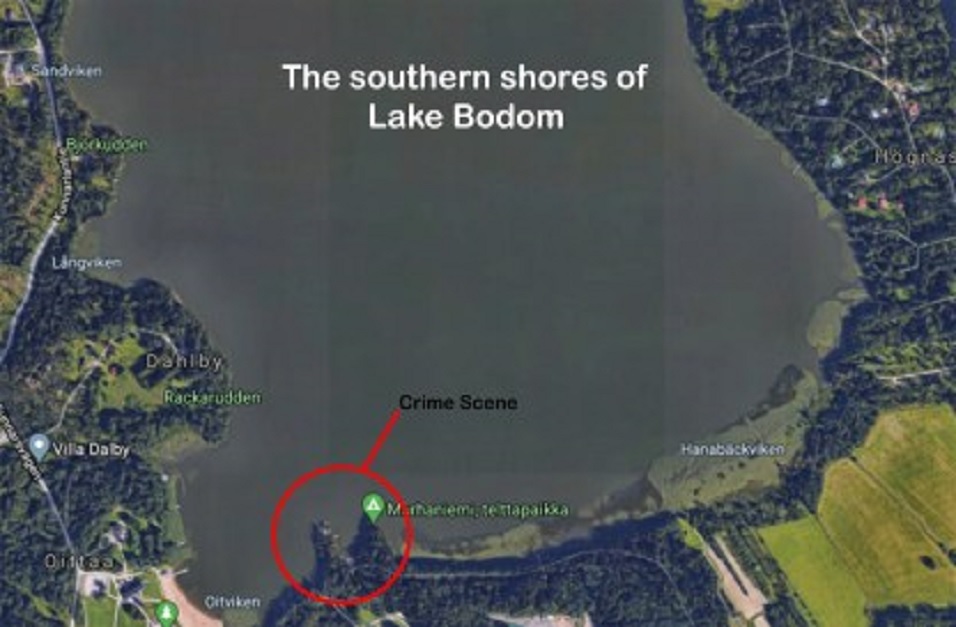
While there is a survivor, his amnesia means night specifics are patchy; known only by scattered snapshots and passing witnesses. We know they swam, fished, and drank some alcohol.
Maila's newspaper was recovered from tent. She had noticed a couple of lines down about her day:
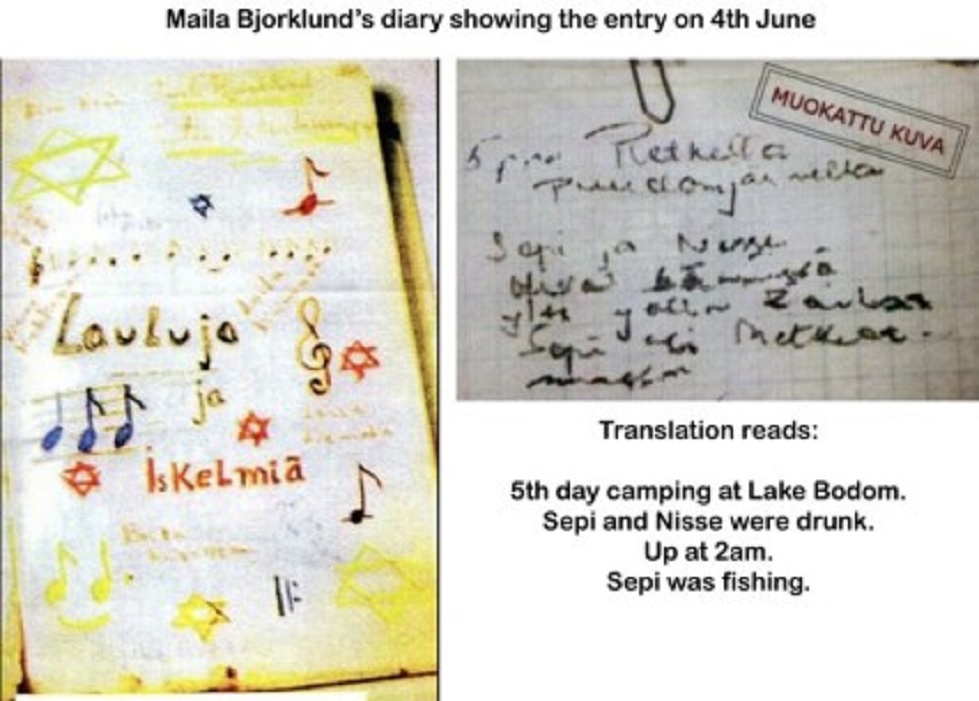
June 5, early morning
While it hardly sets, the morning sun rose at am. Coupled with Lake Bodom's appeal for all kinds of leisure activities, this meant there was only a small window, maybe 3am-5.30am, where the attack may have occurred. After that, we know at least three people who saw a collapsing tent; they didn't understand what they looked at until later that day.
Around 11am carpenter Esko Johansson (often misnamed as Risto Siren in other English articles) started swimming in the lake. Noticing the peninsula's fallen tent, Esko looked closer. It didn't take long to remember he could see blood-covered bodies on top.
He ran with his son to call police at 11:15am. While doing this another man, Sigurt Voulasmaa, also happened on scene. He ran differently to make a similar decision.
The criminal scene
When police arrived, they were shocked to find a total of four bodies, but one showed life signs. Nils Gustafsson lied on his front, largely outside the shelter, dressed except his shoes. He had a blunt force wound, including a fractured jaw and a gash on his lip. The wound was so deep that he could see his teeth through the opening. He also had a strong hit to the back of the head, leaking cerebral fluid through his nose.
Doctors said Gustafsson may have died from his injuries without immediate medical treatment.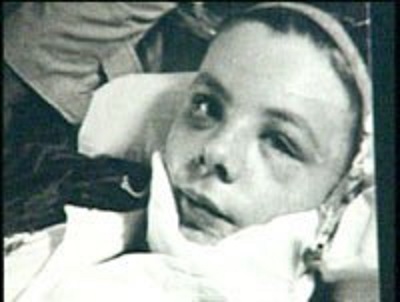
Unfortunately, the attack was more vicious and all three died. Boisman was found lying on his back with neck and chest stab wounds and head bludgeoning. He died of blood inhalation, but his skull sustained terrible trauma, including a fractured jaw.
Anja Maki was fetal on top of the tent. She had been struck hard enough to crack her jaw in two places, yet to knock out at least one tooth.
A hint for motive?
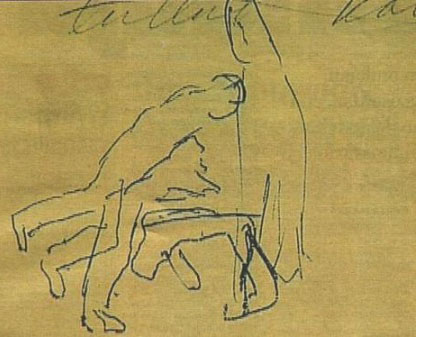 Maila Bjorklund took the assault brunt. She had been neck-and-face stabbed 15 times, bludgeoned, and had defensive wounds on her arms. She was almost nude from the waist down; her jeans pulled one leg completely, half way down the other.
Maila Bjorklund took the assault brunt. She had been neck-and-face stabbed 15 times, bludgeoned, and had defensive wounds on her arms. She was almost nude from the waist down; her jeans pulled one leg completely, half way down the other.
Lake Bodom Murders Enquiry
Someone seemed to have crept up and cut the tent guy-ropes as teens slept. Once it collapsed, starting bludgeoning and stabbing through the cloth was fast. This photograph was taken before Nils went to hospital:
Local police (KRP) will be blamed for encouraging investigators and onlookers to trample the scene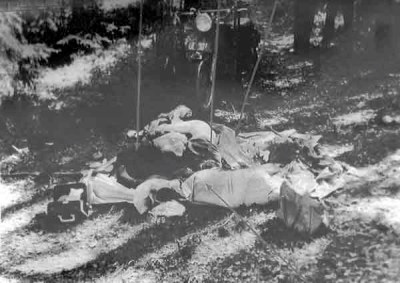 during the day. Criticism of the entire inquiry will follow. Problems were caused by Swedish-speaking police misunderstanding Finnish locals, and allegations of facts were dismissed.
during the day. Criticism of the entire inquiry will follow. Problems were caused by Swedish-speaking police misunderstanding Finnish locals, and allegations of facts were dismissed.
Proof of this
Many belongings of teens were dispersed around the campsite, and initially it wasn't obvious what could be missing.
Over time, it became clear that the killer took both the assassination weapons and numerous other objects. The police and army started a search for the guns and stolen wallets, watches, cigarettes, Seppo's knife and the shoes of both boys.
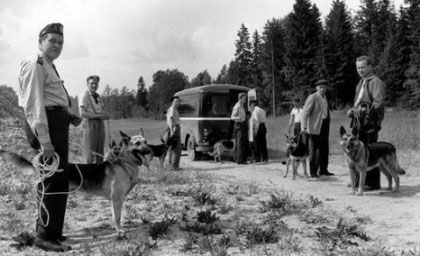 A soft drink bottle was seen bobbing on the shoreline next to the tent. Two fingerprints were lifted, but never matched anyone. It's unclear whether the bottle is part of the evidence, or just floats into the area.
A soft drink bottle was seen bobbing on the shoreline next to the tent. Two fingerprints were lifted, but never matched anyone. It's unclear whether the bottle is part of the evidence, or just floats into the area.
The muddy pillowcase
Next to the tent, a pillowcase was found, wrapped and tied with an elastic band.
This piece of evidence will be very confusing for prosecutors and, later, the courtroom.
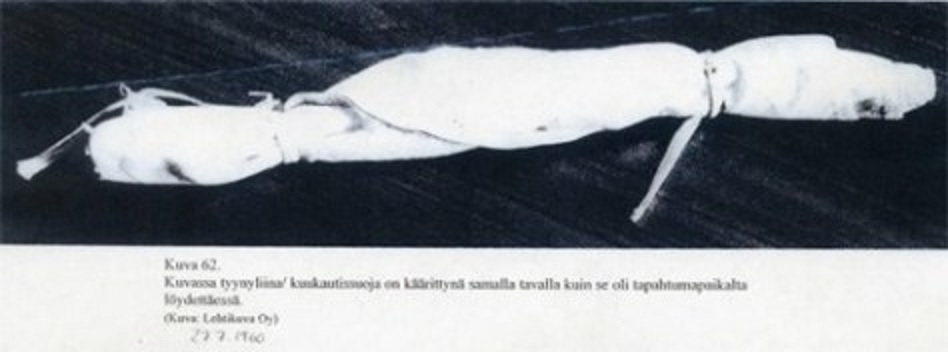
The fabric found both blood and semen. The blood donor could not be determined but could have been a multi-victim combination. This would complicate the type of experiments conducted in 1960 and does not lead to an anonymous donor. The semen couldn't fit any teenage boys, which poses a bigger problem. I will discuss this later in the paper.
Regrettably, other evidence was lost over time. At least two of the victims are thought have bled out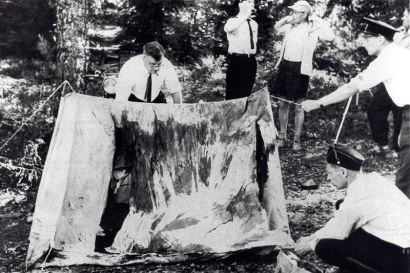 entirely, allowing blood to saturate most of the tent contents. A blanket lining the floor and a leather jacket used as pillow were returned and lost. We will never tell if the evidence contained crucial clues.
entirely, allowing blood to saturate most of the tent contents. A blanket lining the floor and a leather jacket used as pillow were returned and lost. We will never tell if the evidence contained crucial clues.
The only items recovered from the campsite were the boys' shoes. Before dismissing them, the murderer had taken them about 500m south.
Testimonies
During the inquiry, 4000 people were interviewed, a colossal amount for the population. Many valuable witnesses were identified, three of whom had important details.
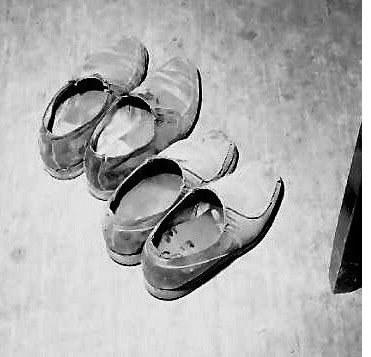 A woman on the lake's west bank saw two young men fishing about 4am. These two men were never named. They may have been Nils and Seppo, but Nils claims to recall where he fished and don't think he was. If not why haven't the two fishermen come forward in Finnish history's most reported criminal case?
A woman on the lake's west bank saw two young men fishing about 4am. These two men were never named. They may have been Nils and Seppo, but Nils claims to recall where he fished and don't think he was. If not why haven't the two fishermen come forward in Finnish history's most reported criminal case?
Nearly two hours later, Kalevi Haapalainen and Heikki Salonen heard loud voices calling for help. They watched and walked west near the campsite. They ventured near the collapsed tent about am.
They saw a blonde man walking off the scene, heading south. They also found a pair of legs on the collapsing tent, whose legs were fiercely debated.
Olavi Kivilahti fished on the campsite's outcrop west, but he never heard any call for help. However, he saw the blond guy walking south from the crime scene and got a good description.
He was 20-30 years old, around 5?8," regularly built with light hair, wearing dark jeans, a light shirt or jacket.
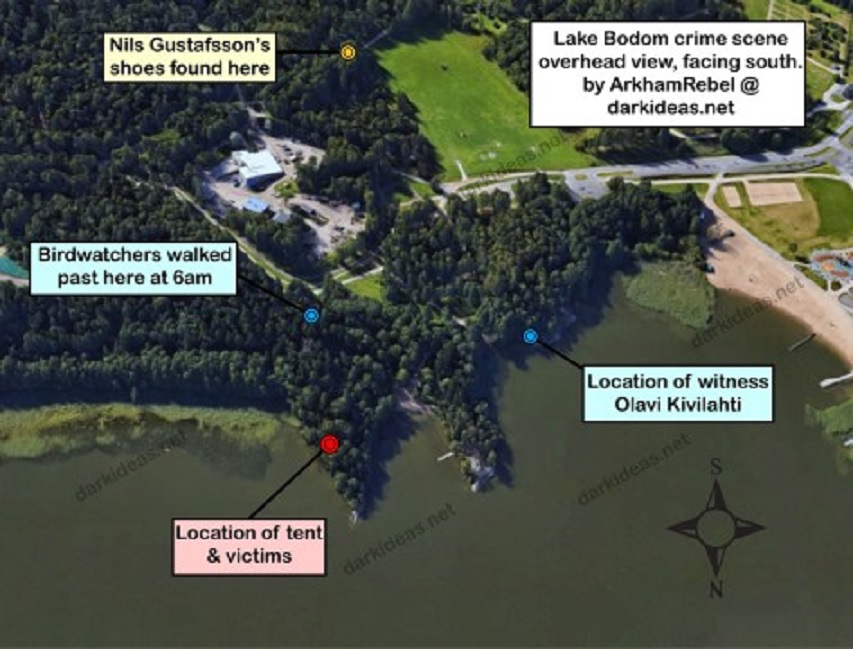
Notable parts of the Lake Bodom Murders crime scene. Notice this view faces south.
Hypnose
Over the years, police have been attracted to blonde man's sightings and who he is. He was the killer, but his identity was never identified. Police also attempted to hypnotize Gustafsson, trying to reveal more of what happened.
The findings are very interesting as under hypnosis, he managed to explain the attack in simple detail. He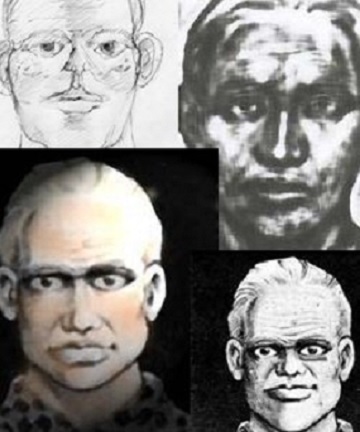 said he awoke as the tent collapsed on them. When the tent was torn during the fenzy, the intruder got a brief glance.
said he awoke as the tent collapsed on them. When the tent was torn during the fenzy, the intruder got a brief glance.
His definition was strikingly similar to Olavi Kivilahti, which further supports the argument against the blonde man. There's no proof that Nils knew about the details provided to police by Olavi. There's a remarkable resemblance between Kivilahti's different sketches and Gustafsson's memories:
But there's also a potential problem with Gustafsson's story. Amnesia caused by brain injury, physicians claim, cannot be remembered during hypnosis. Was Gustafsson telling the truth about his memory?
Lake Kills suspects
Given the apparent similarity between the descriptions, a note of doubt began hanging in the air. Gustafsson will remain one of three suspects in what soon became the century's crime of Finland.
Nils Gustafsson – survivor?
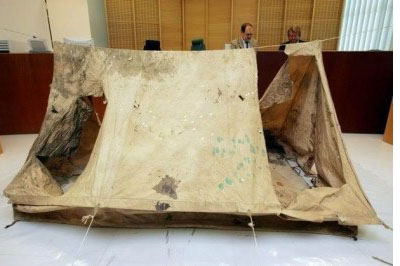 In 2004, the KRP police reported they had done modern-day blood splatter analysis on the tent and Gustafsson's shoes. This prompted them to believe that he had committed the murders and was the most suspect. He was arrested, questioned about the crimes.
In 2004, the KRP police reported they had done modern-day blood splatter analysis on the tent and Gustafsson's shoes. This prompted them to believe that he had committed the murders and was the most suspect. He was arrested, questioned about the crimes.
The tent was stored 44 years before being checked. The green stains are areas analyzed.
Events KRP edition
Police suggested an alternative narrative to a mad 'outsider' attacking group. They found this scenario impossible due to two young men. They created instead a new version of events focused on two linchpins—shoes Gustafsson's and a shocking new witness.
The possibility of a new witness is worrying as she said the two boys visited her and her friends around 1km around Lake Bodom's shore late at night. They were drunk, and Nils tried fighting Seppo. This the police say, is proof Nils' motive to kill his friends.
Why was the woman and her friends 44 years quiet? Researchers and the press ignored this issue. There's absolutely no chance they didn't know they're camping next to one of Finnish history's most sensational cases.
The shoe proof is based on much stronger research. Modern blood splatter analysis revealed police to wear Gustafsson's shoes during the attack. Why would another murderer wear them, remove them, hide them 500m away?
Inconsistent checks
It's quite disappointing because there seems to be no record of whether the police have checked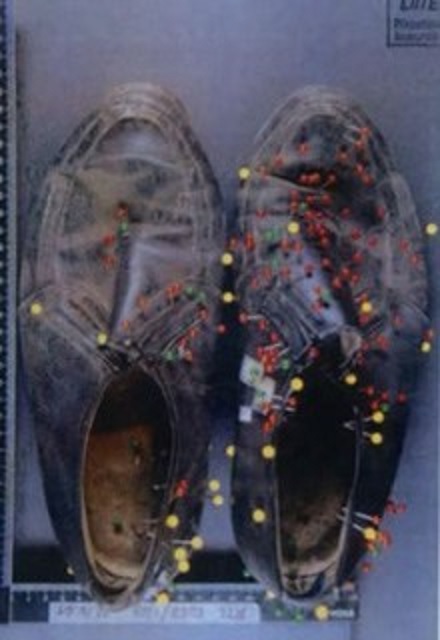 Boisman's shoes. If both boys left their shoes outside the tent, Boisman's would have been a successful control experiment to see in what condition. Maybe I haven't found these translations results.
Boisman's shoes. If both boys left their shoes outside the tent, Boisman's would have been a successful control experiment to see in what condition. Maybe I haven't found these translations results.
Based on witness testimony, police said Gustafsson was banished from the tent after Maila refused his advances. Drunk and furious, he only stormed off later while his friends slept. Cutting the guy-ropes, he first assaulted Seppo, who kicked him in the jaw before succumbing to blows. Next were the girls, with Nils reserving much of his rage for the rejecter.
Many who believe in Gustafsson's guilt say he was the blonde guy as witnesses move away from the tent. Birdwatchers' legs were not his, nor Bjorklund's. His wounds were shallower than medical personnel believed at the time ensuring he could execute all three murders without any difficulty.
Problems with Nils Gustafsson's situation
At first glance, this theory seems sound, the most obvious reason for missing shoes. However, along with the surprise new witness, it seems the police took that and ran with it regardless of the other evidence's inconsistencies. Many unanswered questions remain:
• It does not seem that Gustafsson's clothes were checked. I found no mention of him being blood-splattered from other victims. How could he kill three people, have blood on his shoes?
- Found wearing socks. There's no reason for how he walked back to the tent without leaving traces on his foot.
- Would the same splatter pattern occur if part of the tent dropped over the top half of the shoes?
- Birdwatchers thought the blonde was Nils. Olavi Kivilahiti figured he wasn't.
- All victims, including Nils, had fractured jaws. This means using the same procedure on all four victims.
- Nils had only shallow defensive wounds that he should have handled himself. But should we think he hit himself hard enough on the back of the head to spill cerebral fluid? Or cut his own cheek to touch the teeth?
- Nils' blood was found inside the tent, indicating he was assaulted with friends inside.
The decision
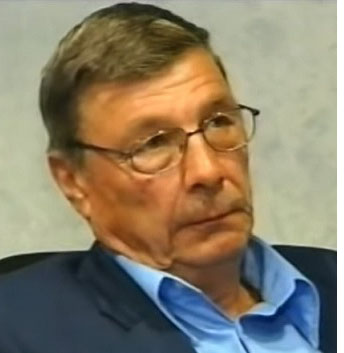 Ultimately, all those questions (and more were enough for the court to decide for him. He was awarded €44,000 in damages as a reflection of how police and media handled him.
Ultimately, all those questions (and more were enough for the court to decide for him. He was awarded €44,000 in damages as a reflection of how police and media handled him.
The pillowcase evidence
The bloody pillowcase with traces of unidentified semen is one of the main problems here. I think I read the translation right in that the situation became so unclear that neither prosecution nor defense wanted it as evidence.
On one hand, we have the chance that research in the 1960s was fooled by fluids combined from several donors. This seems rational, but it's a terrible shame that the proof wasn't re-tested in 2004 (if it still exists). It appears, however that the testing was very positive for an anonymous sperm donor. It's as close as we get physical proof of an outsider committing the attack.
The prosecution was so determined to ignore it that they believed prior campers abandoned it. It's a distant possibility, but it sounds urgent. I assume the prosecution didn't want to include that because they couldn't get any re-tested findings.
With two other suspects waiting in the wings to take center stage, the most pivotal piece of evidence never makes a difference.
Karl Gyllstrom, 'Kioskman'
It's said when they pitched their tent, every witness who lived in the area realized the four teens were not local. No local would have dared to set up camp there, incurring local kiosk owner Karl Gyllstrom's wrath. He considered himself a caretaker of Lake Bodom and hated visitors, particularly children and noisy mopeds. When news of the murders spread, they had just one name on their tongues.
His revenge ranged from hiding razorblades in apples to avoid stealing, throwing rocks at cyclists, and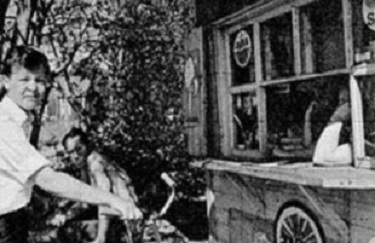 shooting cars.
shooting cars.
Perhaps most alarmingly, he was known to cut tents guy-ropes he didn't want on land. These stories were told to police who in the days after the Lake Bodom Murders, also learned he had mysteriously filled in a well on his farm. Had stuff hidden there?
Unfortunately, little more than a cursory inspection of his property was made until police turned elsewhere. His wife's word, who insisted he was in bed with her all night 4-5 June, was good enough for them.
Speak about town
Locals knew better, not least that Gyllstrom was a mean alcoholic threatening and beating his wife and son. For those who knew him, his name was first on the suspect list. It wasn't helped when his wife, now a widow and on her deathbed, dropped her alibi and claimed she didn't know where he was that night.
By 1969, Gyllstrom had been long dead, committing suicide by drowning in Lake Bodom. No police interest in investigating him despite other friends insisting that he had confessed before he died.
Local politician Ulf Johansson then grew up in the region and was still convinced of Gyllstrom's guilt. He wrote a novel, 'The Bodom Legend,' in which he claims evidence that Gyllstrom spent time in a mental institution. Details were locked 50 years after his death—meaning they should have been accessible in 2019. It'll be fascinating to see if any new knowledge comes to light.
Hans Assman's
It is disappointing that the most interesting suspect was handled quite lazily in English papers. Readers familiar with the Lake Bodom murders will know the usual list of facts that bind him to the crimes. But his story's even more. Not least, he was linked to other murders that fail to gain attention outside Finland and Sweden.
'Bodom's enigma'
In his 2003 novel 'Bodom's Riddle' he introduced Assman to the general public. During a change at Helsinki's Surgical Hospital, he recalled a tale of meeting the German on June 6, 1960. Assman arrived at the emergency room with dirty hands and blood stained clothes. It's uncertain why he asked for treatment, but seemed anxious. At one point, medical personnel believed he faked unconsciousness.
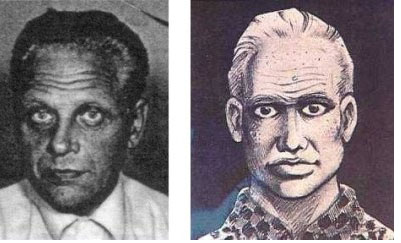 Palo called police, but they're not interested in claims. They never came along to pick up his clothing, positive they would need as evidence.
Palo called police, but they're not interested in claims. They never came along to pick up his clothing, positive they would need as evidence.
Living just 3 miles from Lake Bodom in 1960, Assman also got a haircut when the man's description was published. The contrast to the blonde man is one of his favorite suspects. The sketches based on Gustafsson and Kivilahti's descriptions are remarkably similar:
More than a passing resemblance?
Other more compelling reasons to deem Hans Assman a successful suspect. During World War , he served in the German army, surfacing the first possible myth about him. The famous myth, he was a concentration camp guard at Auschwitz, is most likely a hoax.
His sister presented photographic evidence of obtaining a pension from the German Air Force, The Luftwaffe, to investigators. He may have seen more atrocity than the average person.
He was captured by Russia in 1943 and held as a prisoner of war until 1945; where he became a KGB agent. On release, he finished in Germany where he met his future Finnish wife Vieno. Even accused of being a spy, she used various names in different countries.
He was arrested in 1961 for beating Vieno badly before witnesses, including kicking her on the ground several times. He was found guilty of assault, confirming that when he wished he could return to excess abuse.
In the 1970s, Vieno and Hans divorced and several reports linking him to other crimes originated with his ex-wife. Mostly she said he was always in the same location when the crime occurred.
Strange comments on deathbed
On his deathbed in 1997, a journalist visited him to record the book 'Trust or Death.' Interestingly, whatever Hans Assman's true story, he was considered interesting enough to have a book written about his final days on Earth.
The Lake Bodom crimes asked him specifically, answering:
I guess you expect me to tell you stuff about those tent and knife... I've got to disappoint you, I'm not going to talk about the details, I'm not going to accept or deny anything.
"...will not talk about the details" sounds like a roundabout way of suggesting he knew more than he said. Speaking like that definitely didn't absolve him from a suspicious public. People also claimed the KRP overlooked him for the Lake Bodom Murders due to his KGB connections.
The KRP itself insisted on getting a good alibi for June 4th until June 5th morning. The relevant information was withheld until Nils Gustafsson's 2005 trial. When it transpired that the alibi was no stronger than a distant landlord's word and his wife, it didn't sit well that it was considered 'solid.' They had no justification for Assman's now notorious emergency room ride.
Is this the blond guy, the killer?
In recent years, another picture appeared that further shot. It showed a guy strikingly like Assman attending the Bodom victims' funeral:
This photo, allegedly showing Hans Assman at the Lake Bodom Murder victims' funeral, has gone around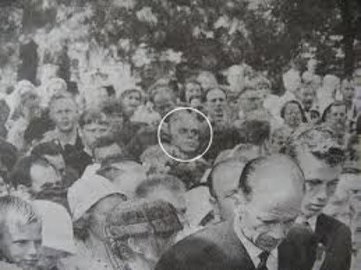 the internet and is hard to trace a source.
the internet and is hard to trace a source.
If the guy in the picture isn't Assman, it's still the blonde man seen walking away from the tent. The sketch-likeness is chilling.
Lumping the other crimes I'm about to list under Hans Assman would be unfair as there has never been any solid evidence to connect him. We must remember he should be treated as innocent, like Nils, until proven otherwise. But the crimes themselves are worth analyzing as they may be the same Lake Bodom murderer's job.
Other notable crimes related to Lake Bodom Murders
Saari Kyllikki
The 17-year-old girl missed while cycling home from a prayer meeting on May 17, 1953. A vehicle was seen driving down the same road with headlights. A later area analysis found skidmarks and broken glass. This led police in Isojoki town (166 miles northwest of Lake Bodom) to speculate that the speeding car could unintentionally hit her.
Her bike was found in marshland in October. A few days later searchers discovered a strange feature in the swamp – as a marker, a sharp stick was pushed into the soft ground. On further inquiry they discovered Kyllikki Saari's badly decomposed body buried.
She had sustained a heavy hit to the head, breaking her nose and cheekbone, which the coroner claimed was caused by a rock-like blunt object. Found nude, decomposition was too advanced to say whether she was sexually assaulted.
Helpful hint
The sharpened stick was odd. The area was searched in June, and then the marker was not seen. The exposed wood age also indicated the murderer had returned to whittle and plant it at least a month after the murder. He forced it so deeply into the ground it pierced Kyllikki's stomach. This conduct does not match well with the accident-killed girl theory.
Hans Assman connection?
Vieno Assman had plenty to say about it. She said Hans owned a car similar to that seen speeding down the Isojoki lane. He was with his driver in that area on May 17 to be believed. Notice that the speeding car witness said there were two passengers. Apparently, when Hans got home, the car had new dents and his shoes wet.
A former police officer believed Assman confessed at one point, explaining his driver accidentally hit the girl. They were on KGB business in the area and hid the body to avoid questioning why they were on the lane.
Assman's biography 'Confidence or Death' appears again in a murder case pages. The journalist who met him to collect the stories is certain that when he said:
"However one thing I should tell you right away... because it's the oldest crime to be secret, otherwise our trip will be exposed. While my friend was a good driver, it couldn't be prevented. You know what I'm saying.
I suspect the auto-translation isn't great here, but it's still simple. Referring to Kyllikki Saari? He played games?
Police may have had a strong suspect
Bodomjarvi.com had an excellent segment on the life of Hans Assman. They believed he stayed in Sweden in 1953. If that's right, he can't have committed this offense. Some police who worked on the case said they knew who the murderer was, but wouldn't seek closure as the man was dead. That doesn't exclude Assman, but it means we'll probably never see proper resolution of this event.
Kyllikki Saari's remains are brought in this 1953 picture to a waiting vehicle. (People's domain)
The Immovable Elli
In December 1955 (two years after Kyllikki Saari) after a late dance in Kemijarvi, Finland, the young student was killed on her way home. She was assaulted as she entered her house at the gate, stabbed her neck and ear. She was found dead on her driveway that night. The only leads police had was a man seen dancing with her the night she died.
Apparently, this definition suited Hans Assman. His wife confirmed at the time that he was in Finland, but there is no evidence for this.
Murders at Tulilahti Camp
A case to be linked to Kyllikki Saari due to some evidence found, plus has echoes of Lake Bodom murders. Of course, if it's connected to the Saari case, that's another clue she wasn't killed by mistake.
Friends Eine Nyyssonen (21) and Riitta Pakkanen (23) went on a bike holiday in July 1959. On July 25, they sent a postcard home saying they'd return on August 3. When they did not return to work on the scheduled date, the alarm was raised and the police retraced their path.
Riitta Pakkanen, Nyyssonen.
Upon arrival at Heinavesi and Tulilahti campsite, the missing girls' tent was identified. Unfortunately, a storm blown through the area damaging several possible facts. It was hard for investigators to collate what happened.
300 volunteers helped scour the campsite's pine trees. When they told searchers to keep an eye out for sharpened sticks pushed into the dirt, we can imagine what police felt.
Sure enough, an army volunteer found a stick marker as expected on August 21. Riitta was bludgeoned with a blunt object (probably rock), and Eine was stabbed. She was stripped naked, but no child was raped.
The sharpened stick coupled with probable rock bludgeoning are clear signs that Kyllikki Saari's killer had struck again.
Suspects – Holstrom
Petty thief Runar Holstrom was arrested and charged on November 6, 1959. The investigation and trial were lengthy and drawn-out, imprisoning Holstrom all the while. In the case against him, prosecutors tried to reconcile certain apparent shortcomings. He was right-handed, while both girls were wounded with left hand. He was also short and slight, unable to take the girls a long distance to their burial site over unforgiving marshland.
As the investigation ploddded along Holstrom's guilt became less persuaded. There was an increasing suspicion that someone who committed these murders also killed Kyllikki Saari six years earlier, but Holstrom was in jail during that crime.
Unfortunately, the trial's tension became too much and Runar Holstrom hanged in his jail, almost 18 months after being detained. He left a note saying: "I'm innocent."
Hans Assman's
This time, there's more than his estranged wife's word to connect Hans Assman to the Tulilahti camp ground murders. Witnesses identified two German men buying a campsite map at a nearby kiosk shortly before the murders. A man's description matched Assman. His ex-wife also reported he'd spent summers at nearby Heinavesi and knew about Tulilahti.
The important issue here is how much M.O. Vieno Assman understood – if the police kept the specifics hidden then it was quite a coincidence for her to accuse Hans of two crimes related to the killer's behaviour.
The Appojaure Murders
The crimes listed so far occurred within 7 years and it seems plausible that one man's work might be considered. But attacks like the Lake Bodom Murders are so rare that a similar case 24 years later remains a possible candidate for the same murderer.
In 1984, 30-something married couple Marinus and Janny Stegehuis moved around Finland and Sweden with a tent for lodging.
On July 12, they were at the edge of Sweden's Sjofallets National Park, at a Lake Appojaure campsite.
They parked their car, set up the tent, and cooked a camping stove evening meal. Death arrived in early hours for them. A couple of hikers came across what, in other conditions, might have been an idyllic scene. The collapsed tent instantly fascinated them.
The peaceful scene is disrupted
Later that day, police in nearby Gallivare city got a call from hikers. They mentioned entering the tent and raising the collapsed material, reeling back when revealing a blood-covered side. Once police arrived, they had to re-erect the tent for exam and examination. Marinus and Janny stabbed and bludgeoned to death inside.
The tent had about 100 knives perforations, and each victim was stabbed at least twenty times. They were evidently sleeping and would have been taken entirely by surprise. Besides the apparent connection with the Lake Bodom Murders, there is an odd contrast with how bodies were discovered. Like Seppo Boisman, Marinus was as though he hadn't been disturbed. His wife, Janny, was bent at the waist at 90 degree angle, her head leaning on her husband's waist. Had she sat up during the attack? This seems like the most logical reason, unless the murderer presented her... and did the same to Lake Bodom's Anja.
It didn't look like their car was destroyed, so theft wasn't a primary motive. Police had no way to verify if anything was taken from the campsite, but over time different things emerged.
Those suspects
Few instances had such a strange past as this. The day after the crime was found, a German cyclist was stopped as he matched a description of someone seen near the lake on the morning. He had no income, checks or credit cards on him, claiming to live off the property. A boxer fighting for the German national team, he couldn't explain why he was in the area or why he chose to travel without money. With no evidence to tie him to the crime scene, police had no choice but to let him go.
A second perpetrator, identified only to the alias 'The Bodybuilder' was local to the area, camping with friends on the night in question at the lake. His friends told police that he had fought and stormed in rage, returning later with bleeding hands and clothing. He clarified that his hunting knife killed a reindeer. A few years later, The Budybuilder was incarcerated for other offences, where a cellmate told police that he admitted the Appojaure murders.
He wasn't pursued as a suspect after committing suicide in a very unusual way to cut off his own arm. Police suspect he could be the murderer, mistakenly killing the Steghuises in the mistaken belief that after their argument, he assaulted his friends' tent.
Thomas Quick/Bergwall
Thomas Fast is his own story, in which his role in the Appojaure murders is just a small portion. Originally considered a 30+ bodycount serial killer, it emerged that all his admissions were fake. A mixture of lucky guesses on his part and poor police work led to his arrest on eight murder charges. All eventually quashed at re-trial.
One case found guilty was Marinus and Janny Stegehuis' murder. Police went as far as setting up the crime scene at the same place and telling him to act on that awful evening. The findings can be seen and will be surprising if true:
Thomas Fast, in the green top shows how he attacked Stegehuis' tent. His confession was full of inaccuracies overlooked by investigators.
Hans Assman's
He moved to Sweden in 1953, but stayed near Stockholm, almost 700 miles south of Lake Appojaure. He would also have been 59 at this attack, but age is not always a limiting factor with serial killers. John Wayne Glover didn't start killing until he was 57, and in his 50s, Harold Shipman also killed. Both of these murderers attacked the aged, meaningful for an aging murderer. The murders discussed here involved much younger victims, but before attacking, I can think of few better ways to subdue a stronger opponent than collapse a tent.
Aside from the Lake Bodom murders, there is only one potential connection to Assman. One of the reported stolen objects from the tent was a camera in a box, Stegehuis' name inside. It was later found in Stockholm in 1984, but the police never knew how it got there. Although a very poor connection to Assman, it still offers evidence that someone traveled the long way to commit the crime.
Conclusions
It's a tragic but probable conclusion that none of these cases will ever be solved. Combining age and poor preservation means new forensic evidence is very unlikely but not impossible. Who can guess what changes can be made in the future to make better use of the available evidence? Until then we can do nothing more than analysis and put the pieces together as best we can.
